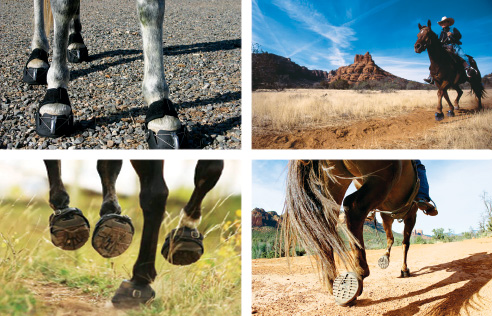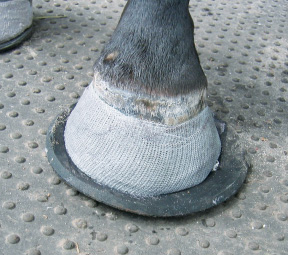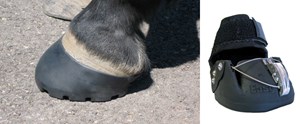You’ve pulled the shoes off your horse, but the transition to a barefoot lifestyle isn’t going quite the way you’d envisioned. Your hoof-care pro says your horse needs to wear boots at least part of the time while his feet adapt, but putting the boots on and off is putting you off.

Does this mean your horse (or your horsekeeping situation) just isn’t cut out for the barefoot thing? Not necessarily. Before you give up, learn about the innovative new tools—and the improvements to old ones—that will help make that transition period much, much easier.
We’ll tell you about these innovations, plus share strategies, advice, and resources for successfully husbanding your horse through the transition to life without metal shoes. In the end, it’ll be your decision as to whether or not the barefoot option will work for you and your horse. The information in this article, however, will at least help you to give that option a sporting chance.
STOP-GAP SUPREME: CASTS
For many horse owners, hoof boots have provided a workable solution for horses that are tenderfooted during the transition phase. That’s the period of anywhere up to six or eight months during which a barefoot hoof’s internal and external structures remodel to form a healthier and more natural foot. Boots with pads provide protection while allowing the natural expansion and contraction that enable a new, tougher hoof capsule to grow out. Lately, innovations in booting (we’ll discuss those in a moment) are promising to make the hoof boot option easier and more appealing all the time.
Some owners, however, just don’t want the hassle of putting boots on and off, especially for turnout. For them, the new application of an existing technology, hoof casting, may be the stop-gap measure they’ve dreamed of.
“Casting combines the healing mechanics of barefoot-with-boots with the convenience of horseshoeing,” says Pete Ramey, a leading expert in the field of natural hoof care. “A cast is ideal for the turnout of horses that are especially tenderfooted because of flat, thin soles or laminitis issues. If boots are going to be impractical for any reason, then casting enables the foot to be stimulated almost as much as if it were totally barefoot, so the horse can build new, healthier feet more quickly.”
Ramey notes that the casting material is not the same as that used for a typical figerglass cast. “Instead, it uses a poly-cloth and resin combination that’s more durable and abrasion-resistant, plus more flexible than a typical cast. So it combines the protection and support of a hoof boot while ‘holding the foot together’ better than a horse shoe, all with little or no maintenance from the horse owner.”
The material is wetted, then wrapped around the lower portion of a properly trimmed hoof. It dries quickly to create what Ramey calls “a semi-permanent, below-the-hairline custom hoof boot” that lasts from two to four weeks, depending on the terrain the horse lives on, and whether or not he’s being ridden.
Top podiatry clinics have been using casts for years, but common use of them in the field has been limited. “This should change,” Ramey says. And although there’s a learning curve to applying the casts, Ramey points out that with a little experience they’re relatively easy to work with—“like wrapping with Vetwrap.” So for the boot-averse owner, they offer a low-hassle alternative that typically retails for under $20, applied, per foot (equicast.com).
BETTER THAN EVER: BOOTS

For many owners, hoof boots will continue to be the transition tool of choice, and sometimes a long-term option when horses are ridden over the roughest terrain. Hoof boots have been rapidly evolving in recent years to respond to the needs of the ever-growing ranks of barefoot horses—and their owners.
“There’s still a lot of room for boots to improve, but we’re getting there,” says Ramey. “Ultimately, we’re working toward hoof boots that will out-perform nailed-on shoes at every sport and activity. This will mean different boots for different purposes, and that’s the direction things are going now.
“The payoff of using boots instead of metal shoes,” he adds, “is far better health—of the hoof and the horse overall—than can be achieved with shoes, and often the best cure for serious hoof problems.”
Ramey has been providing his input to the major boot manufacturer, EasyCare, Inc., and there will be several new lines of boots coming out this fall. Innovations will include lighter weight and a streamlined profile; a glue-on option; built-in padding; and a range of traction variations on the outer sole.
“The low-profile boot we’re working on is almost like a crown on a tooth,” says Garrett Ford, president of EasyCare. “Unless you look closely, you can’t even tell the horse is wearing boots.” Ford, himself an endurance racing enthusiast, used a prototype of the boot during a race in May of this year and said the attending veterinarian didn’t notice that his horse was booted until Ford pointed it out.
Look for the new lines of hoof boots to start hitting the market the last quarter of this year and the first quarter of ’09. In the meantime, even with the models currently available, proper fitting is best done with the help of a hoof-care professional (more on finding that professional in a moment).
“Boots need to be snug to work properly,” says Ford. “It’s the same as for, say, a basketball player—if the footwear is sloppy, it’s not going to work right and it’s going to rub, twist, and come off.”
Easier application is an ongoing development goal, and Ford says the fitting videos available on his Web site (easy
careinc.com) demonstrate basic easy-on methods. “I always tell women not to think of it as a test of strength, but rather a matter of technique,” he says. “My wife is 5’2″ and 100 pounds, and she demonstrates the techniques we recommend on the video clip.”
Ramey says if your horse is especially tenderfooted during the transition period, turnout in hoof boots with pads is a great solution. “The comfort and promotion of healing and remodeling of the hoof are spectacular, but it does require work and dedication on the part of the horse owner,” he says. “You have to clean and inspect the boots and your horse’s hooves daily to avoid problems. A regimen like this works well for some people, and for the rest, we now have the option of casting.”
To determine an on/off boot regimen for your horse, work with your trimmer or farrier. Ramey says in the earliest stages for very tenderfooted horses, 22 hours on and two hours off can be a starting point, from which you can gradually lengthen the time off as your horse’s hooves adapt and remodel.
GETTING HELP—
FROM YOUR FARRIER?
Obviously, the expertise of a good hoof-care professional is key to your success in “transitioning” your horse from shoes to barefoot (or, in the case of a young, still-growing horse, says Ramey, avoiding the transition phase altogether). Though the numbers of qualified trimmers is growing, it can still be a challenge to find one in your area.
Two organizations are now in the process of certifying professionals. The American Hoof Association (AHA; americanhoofassociation.org), a group Ramey helped found, certifies peer-reviewed practitioners. A few names are available now on the group’s Web site, with more to be added. The Association for the Advancement of Natural Horse Care Practices (aanhcp.net—formerly the American Association of Natural Hoof Care Practitioners) also certifies natural-hoof-care professionals.
If you can’t find anyone in your area through these groups, Ramey suggests you recruit your local farrier to learn the barefoot trim.
“Traditional farriers are already knowledgeable about hooves and are therefore in a great position to add a natural trim to their repertoire,” notes Ramey, who began his own career as a traditional farrier. “Do know, however, that there are major differences between the trim a farrier ordinarily does and a barefoot trim. A horse’s foot isn’t naturally flat, the way farriers typically trim it in order to receive a shoe. In a natural state, it arches from front to back, just as our own human foot does. Basically the foot can only be trimmed flat either by thinning the sole at the toe (which you don’t want to do) or by leaving the quarters too long (the quarters are the sides of the hoof wall—the arch of the foot). While this may work if the horse is to be shod, it makes barefoot performance impossible.
“The wrong kind of trim can keep your horse from making the transition to barefoot,” he adds. “Still, I’ve found that farriers are typically quick to master the natural trim, once they make the decision to really learn it.”
If your farrier is interested in learning to do a barefoot trim, there’s a wealth of information on hoof biology, dynamics, and trimming available for free on Pete Ramey’s Web site (hoofrehab.com). Ramey’s book, Making Natural Hoof Care Work For You, is available at his Web site or from www.EquineNetworkStore.com; his new 16-hour DVD series, “Under The Horse” (see “The Portable Clinic,” above) offers the equivalent of a full clinic’s worth of information and training.

Though Ramey is currently taking a break from conducting clinics (to work on a textbook with Robert Bowker, VMD, PhD, director of the Equine Foot Laboratory at Michigan State University’s College of Veterinary Medicine), clinics are available through AHA or AANHCP. In addition, there are schools that teach barefoot trims and other natural-care methods. These include the online Equine Sciences Academy (equinesciencesacademy.com) and the Oregon School of Natural Hoof Care (abchoofcare.com).
Ramey believes farriers are increasingly open to expanding the range of services they offer.
“We’re at the beginning of a major change in the farrier industry,” he predicts. “As horse owners become more educated about their horses’ feet and how foot health relates to horses’ overall wellbeing, they’re going to keep asking farriers about the barefoot option. Equine hoof care (and hoofwear) can, should, and will continue to evolve; so must the hoof professional.”
Editorial Director Jenny Meyer has taken two horses from shod to barefoot and found the process varies with each individual.






